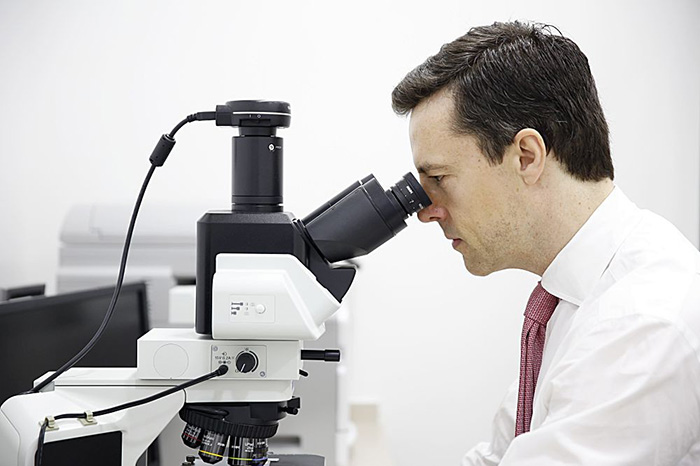Mohs Micrographic Surgery
At The Devonshire Clinic we offer Mohs micrographic surgery for the treatment of skin cancer from our clinic in the Harley Street area of London. Mohs micrographic surgery is used to remove skin cancer and examine the tissue immediately following the procedure. If there is any skin cancer remaining, the surgeon will remove the additional cancerous tissue from the tumour, then immediately examine the remaining tissue during the procedure. This is repeated until the surgeon is happy that there are no cancer cells remaining.

The main difference between Mohs surgery and other surgical techniques for skin cancer, is that the removed tissue is examined immediately, during the surgery, rather than afterwards. This means that the surgeon can be confident that they have removed all the cancer cells, with the smallest possible margin of healthy tissue around them. Mohs skin cancer surgery avoids removing excess healthy tissue around the cancer margin and is therefore associated with better cosmetic outcomes.
How is Mohs surgery performed?
Mohs micrography surgery involves the removal of cancer cells a bit at a time in small layers. Each sample of tissue that is removed during Mohs surgery is examined under a microscope to determine whether cancer cells are present. If cancer cells are found, then their precise location is mapped so that further surgery only takes place where it is needed. The process continues until all trace of cancer cells has been removed.
Mohs surgery step by step
- Cancerous tissue is removed from the tumour site
- The tissue is marked for orientation
- The tissue is mapped
- The tissue is sliced and examined under a microscope to identify cancer cells
- The location of cancer cells is marked on the tissue map
- This map is used to identify areas that require further tissue removal
- Further tissue from these areas is removed and examined
- The process is repeated until all areas are seen to be clear of cancer cells
- Surgery then stops without the need for a margin of error
What are the advantages of Mohs surgery?
Mohs micrographic surgery is superior to traditional excision surgery because it has the highest cure rate (approximately 99%) and the lowest risk of recurrence (<1% at 5 years). It removes all of the skin cancer but leaves as much healthy tissue as possible.
Since many skin cancers occur on the face and neck, this preservation of healthy tissue is a big advantage for cosmetic reasons, since it means that the excision wound is as small as possible and has the best chance to heal with minimal scarring.
What are the disadvantages of Mohs surgery?
The main disadvantage of Mohs surgery is the length of time that the procedure takes.
It can often take several hours, since each layer of removed tissue needs to be individually analysed before surgery can continue. This is longer than traditional cancer excisions. However, in most cases it is worth spending the extra time to be sure that the cancer has been fully removed and that no further surgery will be required. If traditional surgery misses even the smallest amount of cancer cells, you would need a second operation, negating any time saved initially.
Is Mohs surgery right for all skin cancers?
Mohs micrographic surgery has been shown to have a cure rate of at least 98% in basal cell carcinomas and squamous cell carcinomas, which are the two most common forms of skin cancer.
It is ideal for cancers of the face and neck, since it involves the minimum wound size needed to remove the cancer. It is also strongly advised for aggressive or recurrent cancers, since it ensures complete removal of all cancer cells.
Until recently, it was not recommended for malignant melanomas, since these cancer cells were hard to detect under the microscope and could easily be missed, and so the Mohs technique had no advantage. However, with the development of new dyes, known as immunocytochemical stains, which make melanoma cells much easier to spot, the Mohs technique is now used by some for treating melanomas.
Enquire about
Mohs Micrographic Surgery
MOHs micrographic surgery
Read our
Patient Stories
I can’t recommend this clinic highly enough. The treatment I received for my skin cancer was first class
AL, LondonThe team at the Devonshire Clinic were excellent. From booking my appointments to every part of my treatment, I felt that I was in the very best hands.
CH, LondonBefore visiting the clinic I had quite high expectations, but I was blown away by just how brilliant the experience was. I felt like I was the only patient in the clinic. Simply the best medical treatment.
SF, London
When you are faced with difficult medical choices or uncertainty and you want clarity about your diagnosis and the treatment that you will receive, then getting a second opinion from a private doctor can help put your mind at rest.